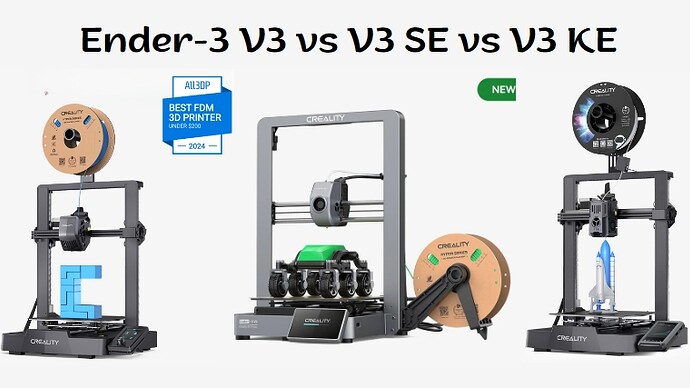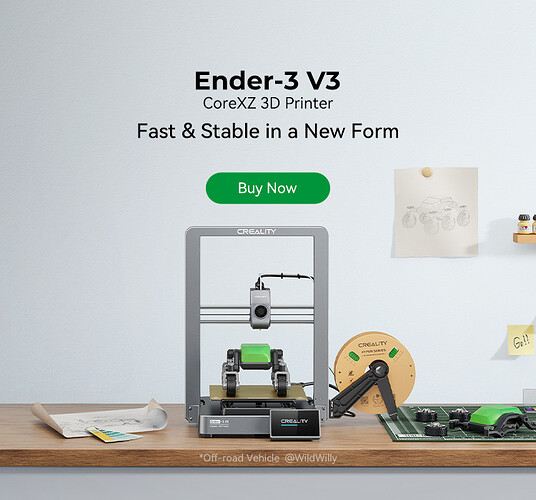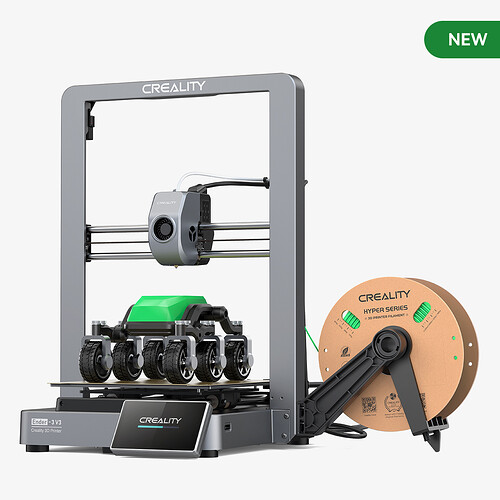The Ender-3 V3, as the latest Ender Series members, was released in Feb. 2024. This model stands out as Creality’s initial foray into employing the CoreXZ motion system for heightened speed and stability. Compared with the Ender-3 V3 SE and V3 KE released in the fall of 2023, there are obvious upgrades in terms of appearance, print quality, and print speed.
This article aims to provide a thorough overview of all three models, helping you choose the best 3D printer for your needs.
Part1: Ender-3 V3 Tech Specifications at A Glance
Let’s explore the technical specifications of the Ender-3 V3, V3 SE, and V3 KE, highlighting key differences in machine details, printing parameters, speed, filament compatibility, features, and beyond.
| Type | Model | Ender-3 V3 | Ender-3 V3 SE | Ender-3 V3 KE |
|---|---|---|---|---|
| Device Information | Release Date | 2024.2 | 2023.8 | 2023.9 |
| Product Dimensions | 358374498mm | 349364490mm | 433366490mm | |
| Net Weight | 7.83kg | 7.12kg | 7.8kg | |
| Display Screen | 4.3 HD touch screen | 3.2’’ Color Knob Screen | 4.3 Color touch screen | |
| Machine Features | Silent Mainboard | √ | √ | √ |
| Power Loss Recovery | √ | √ | √ | |
| Filament Runout Sensor | √ | √ | √ | |
| Leveling Mode | Hands-free auto leveling | Hands-free auto leveling | Hands-free auto leveling | |
| Motion System | CoreXZ | Cartesian | Cartesian | |
| Printing Parameters | Printing Technology | FDM | FDM | FDM |
| Build Volume | 220220250mm | 220220250mm | 220220240mm | |
| Printing Accuracy | ±0.2mm | ±0.1 | ±0.1mm | |
| Layer Height | 0.1-0.35mm | 0.1-0.35mm | 0.1-0.35mm | |
| Sprinting Speed | Typical Printing Speed | 300mm/s | 180mm/s | 300mm/s |
| Max. Printing Speed | ≤600mm/s | ≤250mm/s | ≤500mm/s | |
| Acceleration | ≤20000mm/s² | ≤2500mm/s² | ≤8000mm/s² | |
| Nozzle Components | Extruder Count | 1 | 1 | 1 |
| Extruder | All-metal direct drive extruder | “Sprite” Direct Extruder | “Sprite” Direct Extruder | |
| Nozzle Material | Tri-metal Nozzle Integrated | Copper Alloy | Copper Alloy | |
| Nozzle Diameter | 0.4mm | 0.4mm | 0.4mm | |
| Nozzle Temperature | 300℃ | 260℃ | 300℃ | |
| Supported Filament | Filament Diameter | 1.75mm | 1.75mm | 1.75mm |
| Filament Compatibility | PLA, TPU, PETG, ABS, PLA-CF, PETG-CF, CR-carbon | PLA/PETG/TPU 95A | PLA/PETG/TPU 95A/ABS/ASA | |
| Printing Platform | Build Surface | PEI Flexible build plate | PC Spring Steel Sheet | PEI Flexible build plate |
| Heatbed Temperature | 110℃ | 100℃ | 100℃ | |
| Electronic | Rated Input Voltage | 100-120V~, 200-240V~, 50/60Hz | 100-120V~, 200-240V~, 50/60Hz | 100-120V~, 200-240V~, 50/60Hz |
| Output Voltage | 24V DC | 24V DC | 24V DC | |
| Rated Power | 350W | 350W | 350W | |
| Software | File Transfer | USB drive, WLAN | SD Card | SD Card, WLAN |
| Printable File Format | G-Code | G-Code | G-Code | |
| File Formats for Slicing | STL, OBJ, AMF | STL, OBJ, AMF | STL, OBJ, 3MF | |
| Slicing Software | Creality Print; Cura, Simplify3D, PrusaSlicer | Creality Print; Cura, Simplify3D, PrusaSlicer | Creality Print; Cura, Simplify3D, PrusaSlicer |
Part2: Ender-3 V3, V3 SE, V3 KE Similarities Overview
Let’s start with some similarities between the Ender-3 V3, V3 SE, V3 KE.
1. Quick Assembly Like a Breeze
The first similarity is that all three printers come almost fully assembled, allowing you to kickstart printing within just 20 minutes. With features like one-tap calibration, auto-leveling, and self-testing to ensure hardware integrity, you’ll swiftly receive a prompt to initiate your inaugural print once everything checks out.
2. Electronic Power
The Ender-3 V3, V3 SE, and V3 KE share a common feature: they all operate on a power supply of 100-120V~ or 200-240V~, with a frequency of 50/60Hz, utilizing 24V DC and consuming 350W.
3. Software
The Ender-3 V3, V3 SE, and V3 KE printers are supported by the official Creality Print slicing software. Additionally, they are compatible with popular 3D printing software such as Cura, Simplify3D, PrusaSlicer, and others. This flexibility allows users to choose the slicing software that best suits their preferences and workflow. And all of them support file formats such as STL, OBJ, AMF, and 3mf, generating G-Code for printing.
Part3: Ender-3 V3, V3 SE, V3 KE Differences Details Comparison
Now, Let’s continue to look at the notable differences between the Ender-3 V3, V3 SE and V3 KE.
1. Build Volume
When it comes to build volume, both the Ender-3 V3 and V3 SE share the same build volume as the standard Ender 3, measuring at 220 x 220 x 250 mm. While V3 KE has the smaller build volume measures 220 x 220 x 240 mm. When compared to other Ender series printers like the Ender-3 S1 Plus or the Ender 3 Max Neo, these three printers have a slightly smaller build size. Nevertheless, if you ever need to print a larger project with the V3, V3 SE, or V3 KE, you can always split your model for printing.
2. Printing Speed
The V3 SE, like previous Ender series printers, runs on standard Marlin firmware which has been learning a lot of lessons along the way, enabling the SE to achieve a recommended maximum print speed of 180 mm/s (with a maximum of 250 mm/s) - about three times faster than the average top speed of most other Marlin printers.
Creality released the KE in Sep. 2023 with a closed derivative of the open-source Klipper firmware called “CrealityOS” This firmware allows for advanced functions like linear advance and input shaping. Users have the option to customize it themselves or engage with the open-source community for further exploration. The KE takes advantage of Klipper to reach a maximum speed of 500 mm/s, although its recommend typical is 300 mm/s.
The Ender-3 V3 sticks with Klipper’s open-source firmware but amps up its printing speed, boasting a maximum of 600mm/s* and max acceleration of 20000mm/s²*. It is currently the fastest press in the Ender series.
3. Motion System & Printer Structure
The V3 SE and V3 KE use the standard Cartesian i3 independent motor control motion system to coordinate the printer’s print quality and print speed. In contrast, the Ender-3 V3 uses the CoreXZ motion system, which is different from any previous Ender series printer. Here, all three-axis motors remain fixed, while the XZ timing belts are self-tensioning. This setup reduces printhead weight, increases drive force, and maintains high-speed precision. In addition, the high-precision linear shafts are easy to maintain, requiring only lubrication.
4. Build Plate
The print beds of these three printers can heat up to 100°C (the Ender-3 V3’s heatbed can reach 110°C), ensuring users have no any problems with print adhesion regardless of the filament used. However, the polycarbonate (PC) sheet that comes with the SE model tends to adhere excessively to filaments with higher temperatures. So, we recommend a quick upgrade to a PEI flexible spring steel sheet, akin to what’s available for the Ender-3 V3 and V3 KE.
5. Extrusion & Filament Support
Both the V3 SE and V3 KE come with a “Sprite” Direct Extruder, but they differ in their hotend heaters and supported filaments. The SE has a 40-W heater, reaching a maximum temperature of 260°C, suitable for printing common filaments like PLA, ABS (with an enclosure), PETG, and TPU due to its PTFE-lined heatbreak.
On the other hand, the KE sports a 60-W ceramic heater, allowing for a maximum extrusion temperature of 300°C. With its all-metal bi-metallic heatbreak and copper Volcano-like nozzle, it ensures consistent filament extrusion at various speeds. This setup enables KE users to print high-temperature filaments such as nylon and PC, in addition to common ones.
Meanwhile, the Ender-3 V3 boasts an all-metal integrated design for its nozzle and throat. Compared to the V3 SE and V3 KE, this design ensures smoother material discharge, a longer service life, and effortless maintenance. The all-metal proximal extruder is further evolved, providing stable extrusion force and precise control over consumable flow to ensure high-quality model printing.
6. UI
The SE gets a 3.2-inch knob-controlled screen for printer monitoring and control, while the KE comes with a 4.3-inch color touchscreen on which users can monitor and control every aspect of the printers operation. The Ender-3 V3 has the same 4.3 HD PSI touchscreen like the flagship K1 series.
When it comes to file transfer, the SE has a full-sized SD card slot and a USB-C port. In contrast, the Ender-3 V3 and V3 KE initially offered users the choice of USB, LAN, or wireless transfer via Creality Print or the Creality Cloud mobile app.
7. Price
The V3 SE base model is priced at $199, which is the lowest price among the three printers. Compared with the V3 SE, the V3 KE is priced at $279, less than $100 more expensive. However, it has a print speed of 500 mm/s* and is compatible with high-temperature print filaments. If you want to upgrade to Sprite Extruder 300℃ printing, Ceramic Heating Kit, PEI Flexible build plate, or The total cost of Klipper firmware and upgraded accessories is definitely higher than that of V3 KE.
The Ender-3 V3, is the most expensive option priced at $389. However, it boasts the most advanced CoreXZ motion system, ensuring swift printing at 600mm/s with an accuracy of ±0.2mm. It offers the fastest speed and top-notch quality in the Ender series. Equipped with the same all-metal integrated quick-swap nozzle as the K1C, it simplifies accessory replacement and repair for users. With a versatile 3D printer multifunction enclosure, it represents another flagship version of the product.
Part4: Which One is Right for You? Ender-3 V3, V3 SE, or V3 KE?
Determining the better value for money among the Ender-3 V3, V3 SE, and V3 KE ultimately depends on your personal preferences and priorities.
If cost-effectiveness is your top priority, the V3 SE is the most affordable choice among the three, offering excellent printing speed and quality. It is hailed by all 3dp as the best 3D printer priced under $200 in 2024.
For those looking for faster and smarter 3D printing, the V3 KE is the ideal option. It features a maximum print speed of 500mm/s*; maximum acceleration of 8000mm/s². In addition, it comes with 60W ceramic heater 300°C* copper nozzle, which allows users to print high temperature filaments.
If you’re keen on diving into the advanced and reliable CoreXZ motion system in a fresh configuration, the Ender-3 V3 is an excellent pick. It comes loaded with numerous enhanced features, like the nozzle and extruder found in the Creality K1 series printers, and it supports printing with carbon fiber filament.
In summary, it’s important to recognize that the differences between the Ender-3 V3, V3 SE, and V3 KE are significant upgrades, often considered luxury features.
Conclusion
In conclusion, the Ender-3 V3, V3 SE, and V3 KE are high-end 3D printers offering not only impressive printing speed but also exceptional print quality. Take action now and pick the right 3D printer that aligns with your specific needs and preferences.
Read more:


